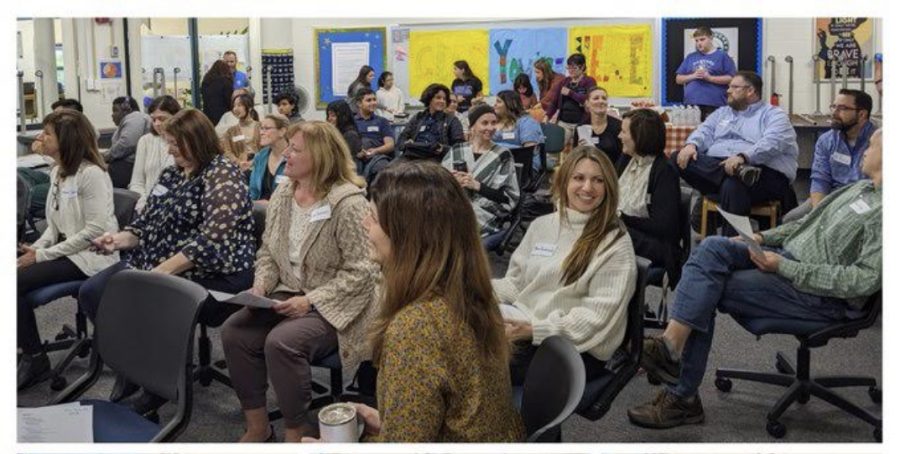English learner students persevere despite unique challenges
Imagine moving out of the country, going to your first day of class, and trying to make sense of a completely unfamiliar environment. You don’t know anyone and the language people speak around you is as foreign as the country itself.
The increasing influx of students at VHHS have lived this reality as they left their old homes with hope for a better life.
Immigrating to the US may not just be a cultural shock, but an academic shock too; especially if they have minor to no prior exposure to speaking English.
To support these new students, they’ll be put into English language learner classes.
According to Wendy Meister-Louria, a VHHS English learner teacher, they have to learn the same standard core curriculum as everyone else, but in a language that may be completely new to them.
“The classes are not easy. They take the same tests, they do the same kind of things, they’re just based around language,” said Meister-Louria.
The English learner classes offered at VHHS aren’t only meant to teach students how to speak English proficiently—they’re also offered to give the same academic opportunities to every student.
According to Meister-Louria, in order to make the language accessible, they’ll use Google translate or make a visual representation of the word. However, this doesn’t make the class any slower, or less rigorous. In fact, it’s the opposite.
“These students have to grow from fourth grade [academic English level] to 12th grade [English level] within four years,” said Meister-Louria.
But that also comes with many challenges, especially in classes that are taught by a non-El teacher.
“If a health teacher gives them an article to read at a ninth grade level, they need help reading that because their reading level is a fourth grade reading level,” Meister-Louria said.
According to Meister-Louria, Driver’s Ed, Health, and Geometry are some of the hardest classes for EL students due to the obscure language the material involves.
Not only are they tasked with learning the material of the class, but they’re also trying to learn the language.
“Your brain cannot work that quickly if it’s working with another language, so they might very easily miss things [that the teacher said],” said Meister-Louria.
To aid EL students in other traditional classes such as Geometry, the program will provide a resource class, where students can go over material in a way that’s more manageable, approachable, and tailored to them. And thus far, it’s been extremely helpful for EL students long-term.
“A lot of our students do end up in traditional honors and AP classes especially in science and math,” Meister-Louria said.
Just like most other VHHS students, they’re going to well-known colleges: UIUC, UNC, University of Colorado, and Cornell are just a few.
However, this past year, there was an unexpected rise in EL students, which has caused overcrowding at lower-level classes. This year, level 1 and level 2 classes were combined due to the expectation that there would only be about 4 students. But now, new students come to VHHS almost weekly, and the EL teachers have been experiencing several challenges.
“The teacher [for level 1 and level 2] can’t give 100% attention to really anyone. What’s required to teach those students in a large group is very challenging,” said Meister-Louria.
Level 1 and level 2 students require different needs and different levels of visual support and explanation.
Nonetheless, the classes along with the resource center have been attentive to the students’ non-academic needs.
“We have kids who left families behind in the literal war zone in Russia and Ukraine. They’re worried about their families. If something bad happens in a place close to their home, how are they going to focus on Algebra?” said Meister-Louria.
Unfortunately, for many students, school can’t be a primary concern when there’s much more grave realities surrounding them.
According to Meister-Louria, students may also get support with all the other challenging things that come with moving to a new country.
“We help them with everything: college applications, filling out FAFSA, filling out forms, getting permission splits…doctors appointments. We help them with homesickness,” Meister-Louria said.
Even day-to-day elements of American school culture are very unique. For example, American schools are the only system in the world that use lockers, emphasize group collaboration, and switch classes. Even things that we learn as early as elementary school, for example learning how to use a calculator, are foreign to them.
Hary Jun (12), who came to the US at a young age from South Korea, can attest to the cultural shock she faced.
“Not only would I not understand the language, I wouldn’t be able to read their body language. Their movements [and mannerisms] were very foreign to me,” said Jun.
Shrieya Praveen (12) faced a similar experience coming from India as a 5 year old—unfamiliar to the food, transportation, and education America had.
“When I first came, I felt so different from everyone else. I couldn’t communicate with anyone. I felt very lost,” said Praveen.
Even as an influx of students have transitioned to VHHS this past year, with a similar experience, EL teachers have shown their constant support.

